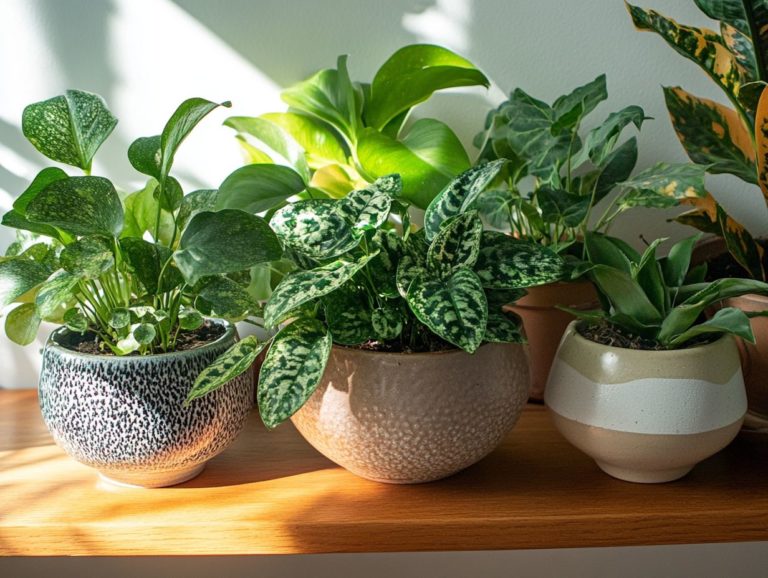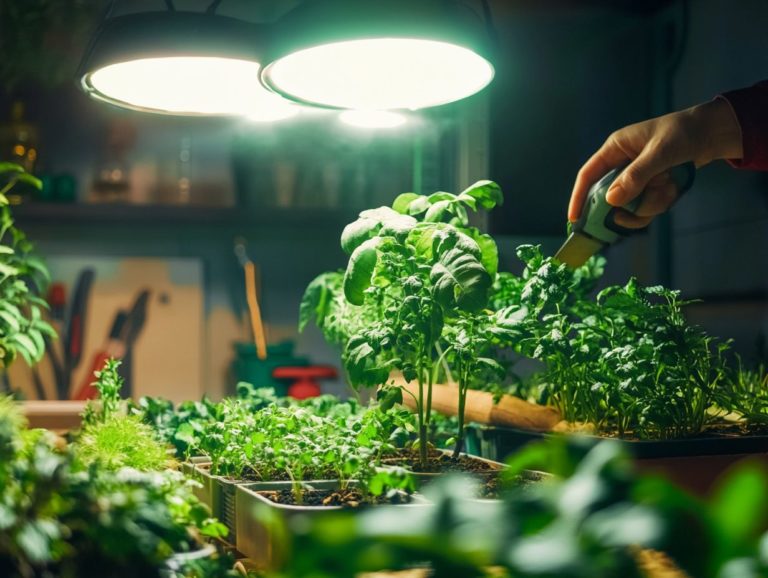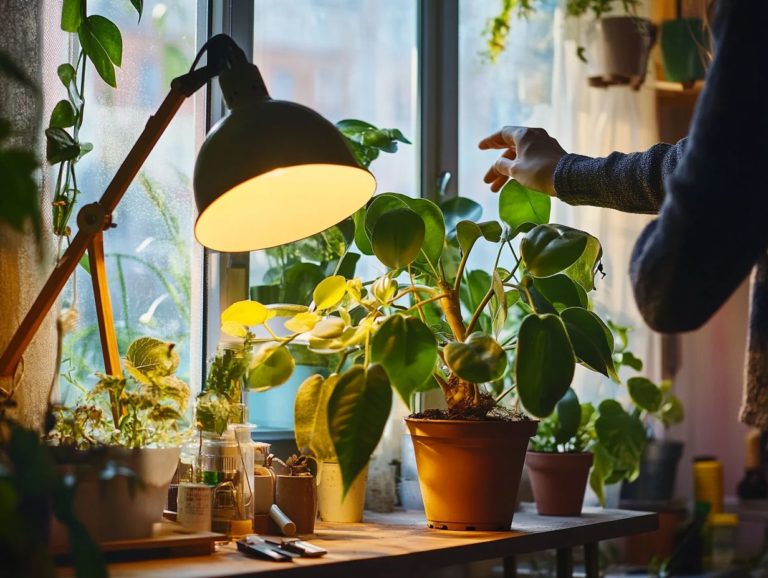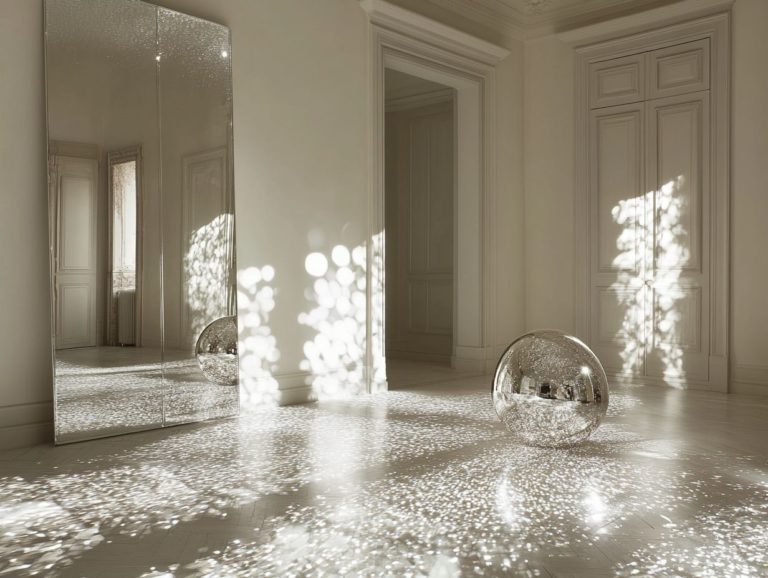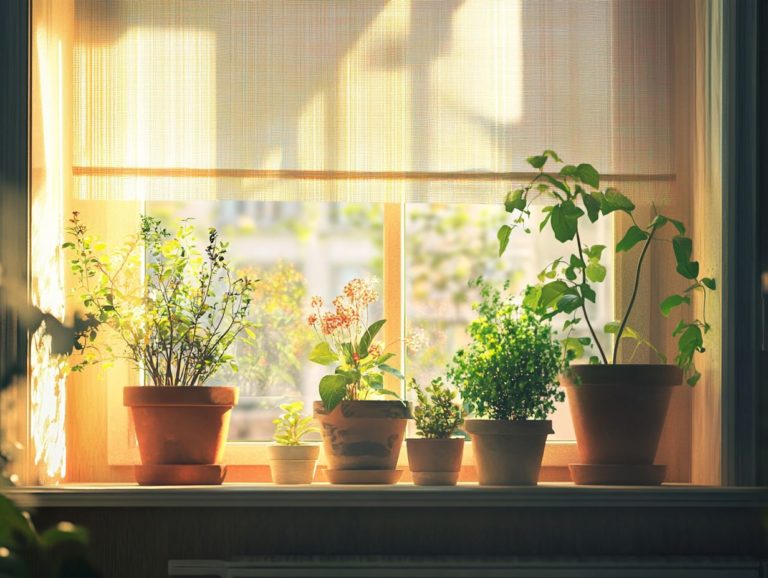Identifying the Right Light for Ferns
Ferns are truly enchanting plants that can effortlessly bring nature’s charm into your indoor spaces or elevate your outdoor areas. Their flourishing beauty largely depends on your understanding of their light needs, especially for various indoor ferns.
In this article, you’ll explore the different types of ferns and their specific light requirements. We’ll guide you through essential factors such as light strength, humidity, and the choice between natural and artificial light sources.
You will also find practical tips for caring for your ferns to ensure they receive the perfect amount of light. This knowledge empowers you to grow lush, vibrant greenery. Create the perfect environment for your ferns today, and watch them thrive!
Contents
- Key Takeaways:
- Understanding Ferns and Their Light Needs
- Factors to Consider When Choosing Light for Ferns
- Types of Light Sources for Ferns
- Best Types of Artificial Light for Ferns
- How to Determine if Your Ferns are Getting Enough Light
- Signs of Insufficient or Excessive Light
- Tips for Providing Optimal Light for Ferns
- Placement and Maintenance of Light Sources
- Frequently Asked Questions
Key Takeaways:

Ferns have varying light needs depending on their types. Some prefer indirect light, while others need direct sunlight.
When choosing light for ferns, consider key factors such as light strength, duration, and whether the lighting is indoor or outdoor.
Natural light is the best source for ferns. If using artificial light, it’s important to select the right type and maintain it properly for optimal growth.
Understanding Ferns and Their Light Needs
Understanding ferns and their light needs is crucial for you as a plant parent who wants to grow thriving indoor ferns. Popular varieties include the Boston fern (Nephrolepis exaltata) and the common tree fern (Alsophila dregei).
These stunning houseplants not only enhance the aesthetics of your indoor spaces but also provide air-purifying benefits, improving overall air quality. By knowing the light requirements and humidity levels specific to these ferns, especially their need for high humidity, you can create the ideal environment for vibrant growth. This ensures your ferns flourish beautifully in your home.
This knowledge lays the foundation for effective fern care, paving the way for lush foliage and healthy plants. It’s especially important to consider seasonal adjustments in care.
Types of Ferns and Their Light Requirements
Many types of ferns exist, each with unique light needs tailored to specific growing conditions. Popular varieties include the Boston fern and low light ferns suitable for indoor gardening.
Understanding these needs is essential for you as a plant parent aiming to cultivate a vibrant indoor garden. For instance, ferns like the Maidenhair thrive in medium light, needing a balance where their delicate fronds can flourish without the scorch of direct sunlight. Proper potting techniques can further enhance their growth.
If you re in a dimmer space, consider low light ferns like the Asparagus fern, which adapts well to lower illumination and benefits from a consistent watering schedule. In contrast, bright indirect light ferns like the Bird’s Nest fern thrive in well-lit environments but still need protection from harsh sunlight to maintain their health and moisture.
By carefully assessing your indoor light conditions, you can choose the right fern variety that not only enhances your home s aesthetic but also ensures optimal growth.
Factors to Consider When Choosing Light for Ferns
When selecting the right light for your ferns, consider vital factors such as light strength, duration, and the differences between indoor and outdoor lighting. These elements are crucial in promoting optimal plant health and encouraging vibrant growth, especially during seasonal adjustments in care.
Light Intensity and Duration
Light intensity and duration are important for the overall health of your ferns. They directly influence moisture levels and affect growth patterns.
Take the Boston fern, for example. It thrives in bright, indirect sunlight, making it ideal for well-lit indoor spaces where air-purifying qualities can shine. In contrast, the maidenhair fern prefers a more subdued environment, flourishing in shaded areas with just a hint of filtered light. This light is crucial for maintaining its delicate structure. Meanwhile, robust varieties like the sword fern show remarkable adaptability, tolerating a range of light from partial shade to bright, dappled sunlight. This makes them suitable for various indoor gardening setups.
To ensure optimal growth, establish consistent watering schedules that align with these varying light conditions and humidity needs. For ferns in brighter spots, keep the soil evenly moist. Those in lower light will appreciate a less frequent watering routine to avoid root rot, which can happen without proper moisture retention. Check moisture levels regularly. This will help you determine the right time to water your ferns, allowing each one to thrive in its unique sanctuary.
Indoor vs. Outdoor Lighting
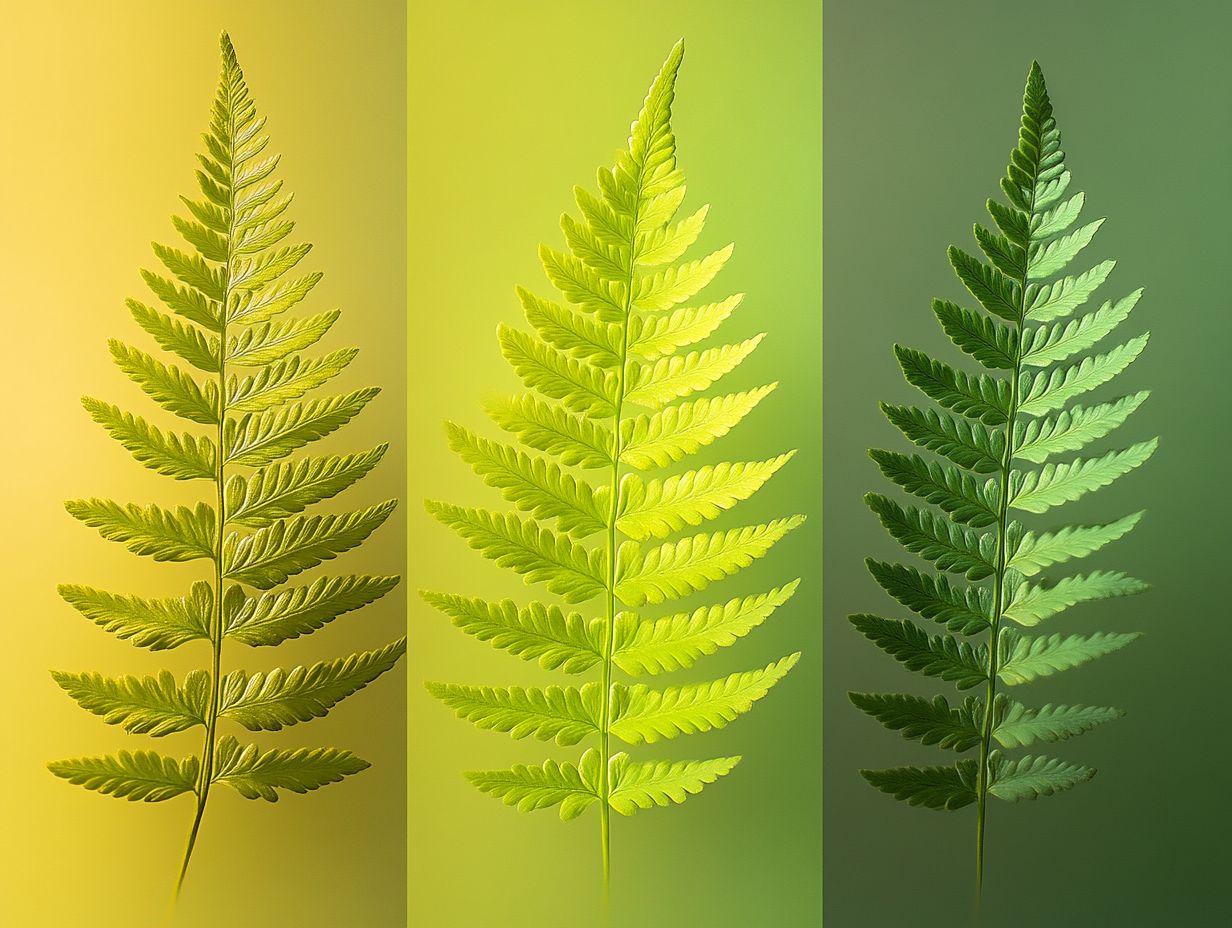
Knowing the differences between indoor and outdoor lighting is key to growing healthy ferns. Each setting offers unique benefits and challenges, especially in tropical areas.
Indoor lighting often provides a more stable environment. It is free from the unpredictable elements that outdoor settings can impose, such as strong winds or quick temperature changes, which can stress your ferns. However, the lack of natural sunlight may lead to lower light levels that don’t fully support growth, making supplemental lighting necessary. Filtered sunlight, mimicking the gentle glow ferns typically enjoy in shaded forest areas, is particularly beneficial for indoor cultivation, ensuring they receive ample indirect light.
Dappled sunlight, with its varied light intensity, can stimulate robust growth and is ideal for many fern species. To keep your indoor ferns thriving and happy, effectively using grow lights can make a significant difference in their overall health and growth. Providing consistent exposure to the right wavelengths that promote photosynthesis, the process by which plants make their food using sunlight, will enhance their vitality and vibrancy.
Types of Light Sources for Ferns
Ferns flourish under a range of light sources, whether it be the gentle embrace of natural sunlight or the consistent glow of artificial lighting. Each option presents distinct advantages for those passionate about indoor gardening, enhancing the beauty and vitality of your green companions.
Natural Light vs. Artificial Light
Natural light and artificial light are vital for the growth of ferns, significantly impacting their overall health and vibrancy. Understanding how to effectively harness these light sources is essential for anyone dedicated to nurturing flourishing indoor ferns.
While natural light is often the preferred choice, it can be somewhat limited by window placement or seasonal changes, leading to inconsistent exposure. In contrast, artificial light allows you to create a controlled environment, providing a steady, tailored source that meets your ferns’ specific needs.
Remember to rotate your ferns occasionally to ensure all sides get plenty of light. Don t underestimate the value of grow lights, especially during shorter winter days. By balancing both types of lighting, you can cultivate an ideal atmosphere for lush, thriving ferns. Start adjusting your ferns’ light conditions today for a healthier plant tomorrow!
Best Types of Artificial Light for Ferns
Selecting the right types of artificial light is crucial for ensuring your ferns receive the proper light intensity they need to thrive, especially during winter when natural light is limited.
Understanding the various types of grow lights can significantly enhance the health and vibrancy of these lush plants. LED grow lights are energy-saving lights that work well indoors. They offer a full spectrum of light that mimics natural sunlight, making them an excellent choice for your ferns.
Fluorescent lights, particularly T5 or T8 fixtures, provide bright illumination without generating excess heat. This makes them a practical option for plant lovers.
While incandescent bulbs are less common, they can offer warmth. However, their lower efficiency and shorter lifespan may make them less than ideal for sustained fern care. Keep an eye on your fern’s light needs it’s key to their happiness! Reducing exposure during winter can help prevent leaf burn, while slightly increasing it in spring will support robust growth.
How to Determine if Your Ferns are Getting Enough Light
Determining if your ferns are receiving the right amount of light is crucial for their overall health. Several signs can reveal whether they are basking in insufficient light or suffering from excessive exposure.
Signs of Insufficient or Excessive Light

Observing the signs of insufficient or excessive light is essential for maintaining the health of your fern fronds. If you notice that the fronds appear leggy, with elongated stems stretching toward the light source, it s a clear indication that your plant isn t getting enough light. Consider reviewing your plant placement.
Fading colors, especially in the vibrant greens characteristic of healthy ferns, can signal an urgent need for brighter conditions. Too much exposure could quickly lead to burnt fronds, evident through crispy edges or discoloration. Seasonal adjustments may be necessary.
To tackle these issues, relocate your fern to a spot that offers filtered light or adjust its placement according to the changing seasons. Regularly rotating the plant helps it receive even light distribution, promoting balanced growth.
Tips for Providing Optimal Light for Ferns
To ensure your ferns thrive, carefully consider the placement and maintenance of your light sources while accounting for humidity levels. Optimal lighting is key to nurturing their health.
Placement and Maintenance of Light Sources
Effective placement and maintenance of light sources are essential for ensuring your ferns receive the right amount of light. Position these delicate plants near bright, indirect sunlight. Direct sunlight can scorch their tender leaves.
If you choose to use artificial grow lights, set them at an appropriate distance around 12 to 24 inches to prevent overheating. Most fern varieties thrive with about 12 to 16 hours of light daily.
For your ferns to flourish, maintain adequate humidity levels between 40 and 60%. Monitoring both light exposure and humidity will help you cultivate a vibrant, healthy fern display.
Watch this video to learn more about caring for your ferns and their light needs!
Frequently Asked Questions
What is the best type of light for ferns?
Ferns love bright, indirect sunlight. This means placing them in a location where they will receive sunlight, but not directly. East-facing windows are typically the best for ferns.
Ready to give your ferns the best light? Start adjusting their spots today!
Can ferns thrive in low light conditions?

While ferns prefer bright, indirect sunlight, some species can thrive in low light. These include Asplenium, Adiantum, and Polypodium. However, they may not grow as quickly or produce as many leaves as they would in brighter light.
How do I know if my fern is getting enough light?
A tell-tale sign that your fern isn’t getting enough light is yellow or brown leaves. This indicates sunburn, so move the fern to a spot with less direct light.
If the leaves are turning pale or drooping, your fern may need more light. It s time to relocate it to a brighter area!
Can I use artificial light for my ferns?
Yes! You can use artificial light if your ferns aren’t getting enough natural light. Use a grow light that mimics natural sunlight.
Keep the light on for 12-14 hours a day for the best growth.
How close should I place my ferns to the light source?
The distance between your fern and the light source depends on the light’s intensity. If using a grow light, follow the manufacturer’s recommendations.
For natural light, place your ferns 2-3 feet away from the window to avoid direct sunlight.
What if my fern is not receiving enough sunlight?
Is your fern drooping? It might be craving more light! If it s not receiving enough light, it may lose leaves or stop growing.
Don t wait move your fern to a brighter spot now! You can also supplement with artificial lighting. Regularly rotating the plant helps ensure all sides receive adequate light.

